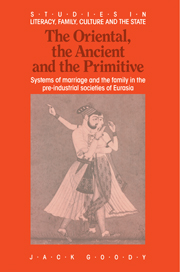 The Oriental, the Ancient and the Primitive
The Oriental, the Ancient and the Primitive Published online by Cambridge University Press: 09 January 2010
This chapter will concentrate upon marriage and the family in Gujarat, and is based upon short spells of fieldwork in India, discussions with the members of the Gujarati community in England and an examination of other studies of the region. A more general reason for starting in the North, apart from the natural sequence following from Tibet, is that in recent years a number of influential analyses of marriage and the family in India have been based on the South and these have tended, at least among anthropologists, to set the themes for the study of the whole of the sub-continent.
Here we begin from a different vantage point, geographically and comparatively. In relation to our general theme, the most relevant works on Gujarat are those of Shah (1956, 1974, 1982) and Pocock on the Kanbi or Patidars (1972 and 1973), the major farming caste of the region. In the introduction to the first of his two studies, Pocock apologises for the lack of information on economic pursuits, indeed on the economy in general. Since he was dealing with a caste of working landowners whose activities were based on their title to that scare resource, land (and the water to irrigate part of it), a resource that was unequally divided between members of the caste, economic factors are clearly of considerable importance. That is especially true where the local productive system is based largely on domestic groups and where marriage involves the differential commitment of resources in order to establish a union among equals or better.
To save this book to your Kindle, first ensure [email protected] is added to your Approved Personal Document E-mail List under your Personal Document Settings on the Manage Your Content and Devices page of your Amazon account. Then enter the ‘name’ part of your Kindle email address below. Find out more about saving to your Kindle.
Note you can select to save to either the @free.kindle.com or @kindle.com variations. ‘@free.kindle.com’ emails are free but can only be saved to your device when it is connected to wi-fi. ‘@kindle.com’ emails can be delivered even when you are not connected to wi-fi, but note that service fees apply.
Find out more about the Kindle Personal Document Service.
To save content items to your account, please confirm that you agree to abide by our usage policies. If this is the first time you use this feature, you will be asked to authorise Cambridge Core to connect with your account. Find out more about saving content to Dropbox.
To save content items to your account, please confirm that you agree to abide by our usage policies. If this is the first time you use this feature, you will be asked to authorise Cambridge Core to connect with your account. Find out more about saving content to Google Drive.